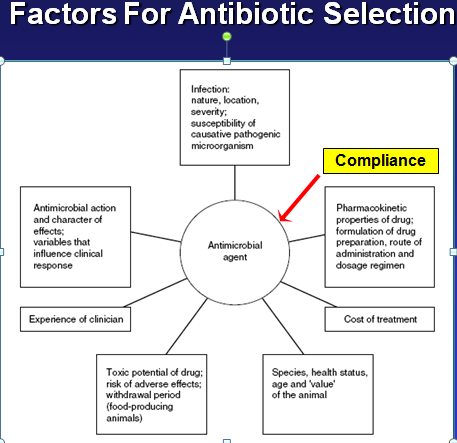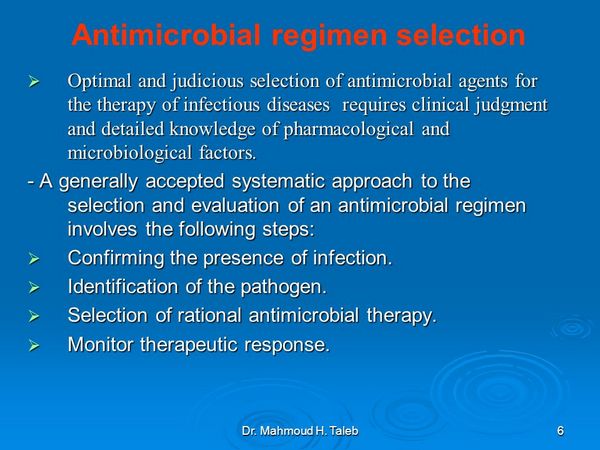| GRAM-POSITIVE COCCI Enterococcus faecalis (generally not as resistant to antibiotics as E. faecium) Serious infection (endocarditis, meningitis, pyelonephritis with bacteremia) Ampicillin (or penicillin G) + (gentamicin or streptomycin) Vancomycin + (gentamicin or streptomycin), linezolid Urinary tract infection Ampicillin, amoxicillin Doxycyclinea fosfomycin, or nitrofurantoin E. faecium (generally more resistant to antibiotics than E. faecalis) Recommend consultation with infectious disease specialist. Linezolid, quinupristin/dalfopristin Staphylococcus aureus/Staphylococcus epidermidis Methicillin (oxacillin)-sensitive PRPc FGC,d,etrimethoprim-sulfamethoxazole, clindamycin,f ampicillin-sulbactam, amoxicillin-clavulante, or fluoroquinolone Methicillin (oxacillin)-resistant Vancomycin + (gentamicin or rifampin) Linezolid, quinupristin-dalfopristin, daptomycin Per sensitivities: Trimethoprim-sulfamethoxazole, doxycycline,a or clindamycin Streptococcus (groups A, B, C, G, and S. bovis) Penicillin Gh or Vi or ampicillin FGC,d,eerythromycin, azithromycin, clarithromycin,j S. pneumoniae Penicillin-sensitive (minimum inhibitory concentration < 0.1 mcg/mL) Penicillin G or V or ampicillin Erythromycin, FGC,d,eazithromycin, or clarithromycinj Penicillin intermediate (minimum inhibitory concentration 0.1-1.0 mcg/mL) High-dose penicillin (12 million units/day for adults) or ceftriaxonee or cefotaximee Gatifloxacinb, levofloxacinb, moxifloxacinb, or vancomycin Penicillin-resistant (minimum inhibitory concentration ≥ 1.0 mcg/mL) Recommend consultation with infectious disease specialist. Vancomycin В± rifampin Per sensitivities: TGC,e,klevofloxacin,b gatifloxacin,b or moxifloxacinb Streptococcus, viridans group Penicillin G В± gentamicinl TGC,d,eerythromycin, azithromycin, clarithromycin,j or vancomycin В± gentamicin GRAM-NEGATIVE COCCI Moraxella (Branhamella) catarrhalis Amoxicillin-clavulanate, ampicillin-sulbactam Trimethoprim-sulfamethoxazole, erythromycin, azithromycin, clarithromycin,j doxycycline,a SGC,e,mTGC,e,kor TGCpoe,nNeisseria gonorrhoeae (also give concomitant treatment for Chlamydia trachomatis) Disseminated gonococcal infection Ceftriaxonee or cefotaximee Oral follow-up: Cefixime,e cefpodoxime,e ciprofloxacin,b or ofloxacinb Uncomplicated infection Ceftriaxonee or cefotaxime,e cefixime,e or cefpodoximee Ciprofloxacinb or ofloxacinb N. meningitides Penicillin G TGCe,kGRAM-POSITIVE BACILLI Clostridium perfringens Penicillin G В± clindamycin Metronidazole, clindamycin, doxycycline,a cefazolin,e imipenem,o meropenem,o or ertapenemo C. difficile Oral metronidazole Oral vancomycin GRAM-NEGATIVE BACILLI Acinetobacter spp. Imipenem or meropenem either В± aminoglycosidep (amikacin usually most effective) Ciprofloxacin,b trimethoprim-sulfamethoxazole, or ampicillin-sulbactam Bacteroides fragilis (and others) Metronidazole BLIC,g clindamycin, cephamycin,e,qor carbapenemo Enterobacter spp. Imipenem, meropenem, ertapenem, or cefepime В± aminoglycosidep Ciprofloxacin,b levofloxacin,b piperacillin-tazobactam, ticarcillin-clavulanate, or trimethoprim-sulfamethoxazole Escherichia coli Meningitis TGCe,k or meropenem Systemic infection TGCe,kAmpicillin-sulbactam, FGC,d,eBL/BLI,g trimethoprim-sulfamethoxazole, SGC,e,mfluoroquinolone,b,o,rimipenem,o meropenemo Urinary tract infection Most oral agents: Check sensitivities. Ampicillin, amoxicillin-clavulanate, trimethoprim-sulfamethoxazole, or cephalexine Aminoglycoside, FGCd,enitrofurantoin, fluoroquinoloneb,o,rGardnerella vaginalis Metronidazole Clindamycin Hemophilus influenzae Meningitis Cefotaximee or ceftriaxonee Meropenemo or chloramphenicolr Other infections BLIC,g or if β- lactamase-negative, ampicillin or amoxicillin Trimethoprim-sulfamethoxazole, cefuroxime,e erythromycin, azithromycin, clarithromycin,j or fluoroquinoloneb,o,rKlebsiella pneumoniae TGCe,k (if Urinary tract infection only: Aminoglycosidep) Trimethoprim-sulfamethoxazole, cefuroxime,e fluoroquinolone,b,rBLIC,g imipenem,o or meropenemo Legionella spp. Erythromycin В± rifampin or fluoroquinoloneb,r Trimethoprim-sulfamethoxazole, clarithromycin,j azithromycin, or doxycyclinea Pasteurella multocida Penicillin G, ampicillin, amoxicillin Doxycycline,a BLIC,g trimethoprim-sulfamethoxazole or ceftriaxonee,kProteus mirabilis Ampicillin Trimethoprim-sulfamethoxazole, most antibiotics except PRPc Proteus (indole-positive) (including Providencia rettgeri, Morganella morganii, and Proteus vulgaris) TGCe,k or fluoroquinoloneb,r Trimethoprim-sulfamethoxazole, BLIC,g aztreonam,t imipenem,o or TGCpoe,nProvidencia stuartii TGCe,k or fluoroquinoloneb,r Trimethoprim-sulfamethoxazole, aztreonam,t imipenem,o or meropenemo Pseudomonas aeruginosa Cefepime, ceftazidime, piperacillin-tazobactam, or ticarcillin-clavulanate plus aminoglycosidep Ciprofloxacin,b levofloxacin,b aztreonam,t imipenem,o or meropenemo Urinary tract infection only: Aminoglycosidep Ciprofloxacin,b levofloxacin,b or gatifloxacinb Salmonella typhi Ciprofloxacin,b levofloxacin,b ceftriaxone,e or cefotaximee Trimethoprim-sulfamethoxazole Serratia marcescens Piperacillin-tazobactam, ticarcillin-clavulanate, or TGC,e,kВ± gentamicin Trimethoprim-sulfamethoxazole, ciprofloxacin,b levofloxacin,b aztreonam,t imipenem,g meropenem,a or ertapenem Stenotrophomonas (Xanthomonas) maltophilia Trimethoprim-sulfamethoxazole Generally very resistant to all antimicrobials; check sensitivities to ceftazidime,e ticarcillin-clavulanate, doxycycline,a and minocyclineaMISCELLANEOUS MICROORGANISMS Chlamydia pneumoniae Doxycyclinea Erythromycin, azithromycin, clarithromycin,j or fluoroquinoloneb,rC. trachomatis Doxycyclinea or azithromycin Levofloxacinb or ofloxacinb Mycoplasma pneumoniae Erythromycin, azithromycin, clarithromycinj Doxycyclinea or fluoroquinoloneb,rSPIROCHETES Treponema pallidum Neurosyphilis Penicillin G Ceftriaxonee Primary or secondary Benzathine penicillin G Doxycyclinea or ceftriaxonee Borrelia burgdorferi (choice depends on stage of disease) Ceftriaxonee or cefuroxime axetil,e doxycycline,a amoxicillin High-dose penicillin, cefotaxime,e azithromycin, or clarithromycinj |
| a Not for use in pregnant patients or children younger than 8 yr. b Not for use in pregnant patients or children younger than 18 yr. c Penicillinase-resistant penicillin: nafcillin or oxacillin. d First-generation cephalosporins – intravenous: cefazolin; PO: cephalexin, cephradine, or cefadroxil. e Some penicillin-allergic patients may react to cephalosporins. f Not reliably bactericidal; should not be used for endocarditis. g β- Lactamase inhibitor combination – intravenous: ampicillin-sulbactam, piperacillin-tazobactam, ticarcillin-clavulante; PO: amoxicillin-clavulanate. h Either aqueous penicillin G or benzathine penicillin G (pharyngitis only). i Only for soft tissue infections or upper respiratory infections (pharyngitis, otitis media). j Do not use in pregnant patients. k Third-generation cephalosporins – intravenous: cefotaxime, ceftriaxone. l Gentamicin should be added if tolerance or moderately susceptible (minimum inhibitory concentration >0.1 g/mL) organisms are encountered; streptomycin is used but may be more toxic. m Second-generation cephalosporins – intravenous: cefuroxime; PO: cefaclor, cefditoren, cefprozil, cefuroxime axetil, and loracarbef. n Third-generation cephalosporins – PO: cefdinir, cefixime, cefetamet, cefpodoxime proxetil, and ceftibuten. o Reserve for serious infection. p Aminoglycosides: gentamicin, tobramycin, and amikacin; use per sensitivities. q Cefoxitin, cefotetan. r intravenous/PO: ciprofloxacin, ofloxacin, levofloxacin, gatifloxacin, and moxifloxacin. s Reserve for serious infection when less toxic drugs are not effective. t Generally reserved for patients with hypersensitivity reactions to penicillin. |
|




 (1 votes, average: 4.00 out of 5)
(1 votes, average: 4.00 out of 5)



